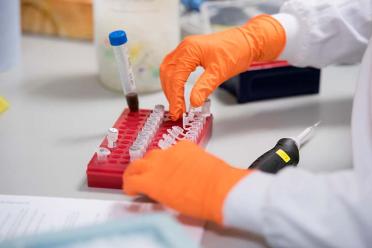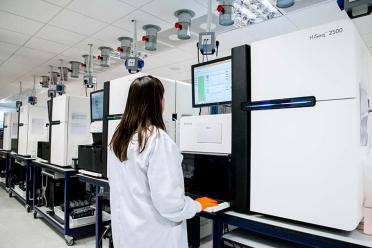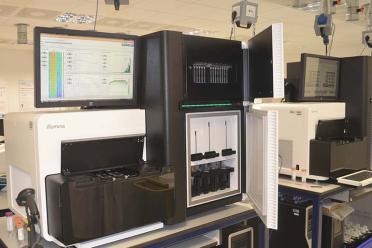Discover Earlham Institute at New Scientist Live 2016
Our wide-ranging research into animal, plant and microbial genomics helps us improve breeding, withstand disease and enhance yields for future generations.
Start date:
22 September 2016
End date:
25 September 2016
Venue:
ExCeL London
Organiser website:
https://live.newscientist.com/
Cost:
£25.00 - £29.00 per ticket
New Scientist Live is a festival of ideas and discovery, taking place at ExCeL London. Rooted in the biggest, best and most provocative science, New Scientist Live will touch on all areas of human life. The show will feature four immersive zones covering Brain & Body, Technology, Earth and Cosmos. For four days this September, New Scientist Live will be like no other place on earth.
Earlham Institute will be present in the technology section, showcasing what goes on behind the scenes in delivering the latest advances in bioscience - from massive supercomputing power to next-generation genome sequencing hardware.
We are running a competition to find your favourite Earlham Institute technology at this years New Scientist Live! Simply tweet us @EarlhamInst with your fav piece of kit and you'll be entered in to win a £25 iTunes voucher. Terms and conditions below.
The rules of the competition and how to enter are as follows:
No tweets available for @EarlhamInst
We can't do our science without the latest technology. Science is just too big and complex of a job - from the huge amounts of data produced, which all needs analysing, storing and processing, to collaborating with other researchers all around the world. We often need to work with lots of different types of data too, held in all kinds of databases and repositories..
Other problems we face include generating the data in the first place, especially concerning large and complicated genomes, such as wheat (which is much larger and more complicated than even the human genome). We use next-generation sequencing technologies to explore these genomes and specially configured supercomputing systems to analyse it.
Here you can find out about the way we work with technology and how we apply it to answering all sorts of important questions in biology.



One of the latest pieces of kit in the next generation sequencing armoury, the Illumina HiSeq works by reading short fragments of DNA (150-250 base pairs), by adding single base pairs at a time and imaging the flashes of light that these produce.
To prepare a “library,” DNA is first randomly fragmented into small fragments, which then have special adapters added to the end.
The DNA library is inserted into a “flow cell,” which is dotted with small stretches of DNA that attach to the adapters at the end of our small fragments.
Through a technique known as “bridge amplification,” these fragments are amplified in clusters. Essentially, each distinct fragment is copied many times, with the copies clustering in the same location due to them being attached via the adapters. Thus - there are many thousands of copies of each fragment to be sequenced.
The Illumina HiSeq can then sequence the DNA by imaging single base pairs of DNA as and when they are added to the sample.
An added base pair (A, T, G or C) is detected by taking images - each letter giving off a different flash of light.
These base pairs come attached with a special terminator, which ensures that only one base pair is added to each fragment at any one time. This means that every single fragment of DNA can be imaged at the same time, providing letter-by-letter sequencing.
Once a round of imaging has been completed, a solution is added that removes the terminator from the imaged base pairs, so that the detection cycle can proceed.
It takes around one hour to image a single flow cell, which is why it takes up to ten days to run an entire genome on one of these machines after hundreds of rounds of imaging (substantially quicker than the 13 years it took to sequence the first human genome).
The accuracy of these machines is quite high, with Illumina HiSeq de-novo sequencing producing an error rate of only around 0.01%.
These next generation sequencing machines form another important part of the Platforms & Pipelines process, allowing us to sequence long stretches of a single molecule of DNA, which can inform and improve genome assemblies and help us identify novel genes that on first appearances seem very similar.
Unlike the Illumina HiSeq and MiSeq machines, the PacBio can read many thousands of DNA base pairs (A, T, G and C) during each run. This can be very useful indeed.
With stretches of DNA of only 150-250 base pairs, it can be difficult, or impossible, to differentiate between some very similar genes - for example those involved in plant defence.
Many plant defence proteins have arisen through duplications in gene sequences, therefore might have only a few differences between them.
The PacBio, with longer reads, can help separate these and inform us of the true diversity within plant defenses, which can help us to identify novel genes that could help us to breed more hardy crops.
Listen to Dave and Naomi explain how these essential technologies are being used at Earlham Institute.
Not all of our lab equipment is for DNA sequencing. Sometimes, we need tools that help us to better stitch a genome together in the correct order - which is where the Irys comes in.
This useful piece of kit allows us to snip pieces of DNA in specific places on only one of the two strands, which are then labelled with a marker.
Fragments of DNA can then be assembled together in the correct order depending on where the snipped and labelled sites match up, which helps our bioinformaticians to improve their genome assemblies.
Listen to Dave Baker explain how this works.